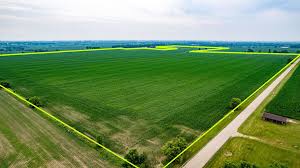Have you ever tried to picture 200 acres in your mind? It’s one of those measurements that sounds enormous, but without a frame of reference, it’s hard to grasp just how vast it really is.
Whether you’re a farmer planning your next harvest, a real estate investor evaluating a property, or just someone curious about land measurements, understanding the scale of 200 acres can be incredibly useful.
To put it into perspective, 200 acres is roughly equivalent to 151 football fields or 150 city blocks .But what does that actually mean in practical terms? Let’s dive into some common comparisons to help you visualize this expansive area.
How Big is 200 Acres?
200 acres is a unit of area commonly used in land measurement, especially in agriculture, real estate, and urban planning. To put it simply, one acre is about the size of a football field without the end zones.

Multiply that by 200, and you’ve got a sprawling piece of land that could fit 151 football fields side by side. But why does this matter? Understanding the size of 200 acres can help you make informed decisions, whether you’re buying property, planning a development project, or just satisfying your curiosity about the world around you.
Now, let’s explore thirteen common comparisons to help you visualize just how big 200 acres really is.
1. Football Fields
Football fields are a classic way to visualize large areas, and for good reason. A standard American football field, including the end zones, measures about 1.32 acres. Without the end zones, it’s roughly one acre. This means 200 acres could fit approximately 151 football fields.
Football fields are not only a familiar sight but also a practical way to understand large-scale measurements. Whether you’re a sports fan or not, picturing 151 football fields laid out side by side gives you a sense of the sheer size of 200 acres.
Fun Fact: The largest football stadium in the world, the Rungrado 1st of May Stadium in North Korea, covers about 51 acres—just a fraction of 200 acres!
2. Central Park
Central Park in New York City is one of the most famous urban parks in the world, spanning 843 acres. While 200 acres is significantly smaller than the entire park, it’s still a substantial area. To put it into perspective, 200 acres is roughly equivalent to one-fourth of Central Park.

Central Park is a great comparison because it’s a well-known landmark that many people have visited or seen in movies and TV shows. Imagining a quarter of this iconic park helps you grasp the scale of 200 acres in an urban setting.
Fun Fact: Central Park is so large that it contains 58 miles of walking paths, 36 bridges, and 21 playgrounds.
3. The Vatican City
The Vatican City, the smallest independent state in the world, covers an area of about 110 acres. This means 200 acres is nearly twice the size of the entire Vatican City.
The Vatican is a fascinating comparison because it’s a place many people associate with grandeur and history. Imagining a piece of land twice as large as this sovereign state gives you a sense of how expansive 200 acres truly is.
Fun Fact: Despite its small size, the Vatican City is home to some of the world’s most famous landmarks, including St. Peter’s Basilica and the Sistine Chapel.
4. Shopping Malls
Large shopping malls are another great way to visualize 200 acres. For example, the Mall of America in Minnesota covers about 96 acres, including its parking lots. This means 200 acres is more than double the size of this massive shopping complex.
Shopping malls are a relatable comparison because they’re places many people visit regularly. Imagining a space twice as large as the Mall of America helps you understand the scale of 200 acres in a commercial context.
Fun Fact: The Mall of America is so big that it can fit 32 Boeing 747 airplanes inside its main building.
5. Golf Courses
A standard 18-hole golf course typically covers about 125 to 150 acres. This means 200 acres could comfortably fit one and a half golf courses.
Golf courses are an excellent comparison because they’re designed to be spacious and sprawling. Imagining a piece of land large enough to accommodate one and a half golf courses gives you a sense of the vastness of 200 acres.
Fun Fact: The largest golf course in the world, the Mission Hills Golf Club in China, spans a staggering 20 square miles—far larger than 200 acres!
RAED THIS : How Long is 100 Kilometers? 11 Common Comparisons (+Pics)
6. City Blocks
In many U.S. cities, a standard city block is about 2.5 acres. This means 200 acres is equivalent to roughly 80 city blocks.
City blocks are a practical comparison because they’re a common feature of urban landscapes. Imagining 80 city blocks laid out side by side helps you visualize the scale of 200 acres in a city setting.
Fun Fact: Manhattan, one of the most densely populated areas in the world, has approximately 2,000 city blocks.
7. Farmland
For those familiar with agriculture, 200 acres is a significant amount of farmland. To put it into perspective, 200 acres is enough to grow approximately 15,000 bushels of corn or 12,000 bushels of wheat, depending on the yield.
Farmland is a meaningful comparison because it highlights the practical uses of large areas of land. Imagining 200 acres of crops helps you understand the scale of agricultural operations.
Fun Fact: The average farm size in the United States is about 444 acres, meaning 200 acres is just under half the size of an average farm.
8. The Great Pyramid of Giza
The Great Pyramid of Giza, one of the Seven Wonders of the Ancient World, covers an area of approximately 13 acres. This means 200 acres is more than 15 times the size of this iconic structure.
The Great Pyramid is a fascinating comparison because it’s a symbol of human ingenuity and scale. Imagining a piece of land 15 times larger than this ancient marvel helps you grasp the enormity of 200 acres.
Fun Fact: The Great Pyramid was the tallest man-made structure in the world for over 3,800 years, standing at 481 feet tall.
9. Disneyland
Disneyland in Anaheim, California, spans about 85 acres. This means 200 acres is more than double the size of this beloved theme park.
Disneyland is a relatable comparison because it’s a place many people have visited or dreamed of visiting. Imagining a space more than twice as large as Disneyland gives you a sense of how expansive 200 acres truly is.
Fun Fact: Disneyland attracts over 18 million visitors annually, making it one of the most visited theme parks in the world.
10. The National Mall
The National Mall in Washington, D.C., covers approximately 146 acres. This means 200 acres is about 1.4 times the size of this historic and cultural landmark.
The National Mall is a meaningful comparison because it’s a place of national significance, home to monuments, museums, and events. Imagining a piece of land 1.4 times larger than this iconic space helps you visualize the scale of 200 acres.
Fun Fact: The National Mall hosts over 3,000 events each year, including presidential inaugurations and the National Cherry Blossom Festival.
11. The Boeing Everett Factory
The Boeing Everett Factory in Washington state, the largest building in the world by volume, covers about 98 acres. This means 200 acres is more than double the size of this massive manufacturing facility.
The Boeing Everett Factory is an excellent comparison because it’s a place of industrial significance, where some of the world’s largest airplanes are built. Imagining a space twice as large as this facility gives you a sense of the vastness of 200 acres.
Fun Fact: The Boeing Everett Factory is so large that it has its own fire department, medical clinic, and water treatment plant.
12. The Principality of Monaco
Monaco, the second-smallest country in the world, covers about 499 acres. This means 200 acres is roughly 40% the size of this sovereign state.
Monaco is a fascinating comparison because it’s a place of luxury and prestige, known for its casinos, yacht-lined harbor, and Grand Prix. Imagining a piece of land nearly half the size of Monaco helps you understand the scale of 200 acres.
Fun Fact: Despite its small size, Monaco is one of the most densely populated countries in the world, with over 26,000 people per square mile.
13. The University of Notre Dame Campus
The University of Notre Dame’s main campus in Indiana spans about 1,250 acres. This means 200 acres is roughly 16% the size of this prestigious university’s grounds.
The University of Notre Dame is a practical comparison because it’s a place of education and tradition, with sprawling lawns, historic buildings, and athletic facilities. Imagining a piece of land 16% the size of this campus helps you visualize the scale of 200 acres.
Fun Fact: The University of Notre Dame’s football stadium, Notre Dame Stadium, is one of the most iconic in college sports, with a seating capacity of over 77,000.
Real-World Applications & Practical Measurement Tips
Understanding the size of 200 acres isn’t just an academic exercise it has real-world applications. For example, if you’re a real estate investor, knowing how to visualize 200 acres can help you evaluate potential properties.
If you’re a farmer, it can help you plan crop rotations and irrigation systems. Even if you’re just a curious individual, understanding this measurement can give you a deeper appreciation for the world around you.
Here are some practical tips for estimating large areas like 200 acres:
- Use familiar landmarks, like football fields or city blocks, as reference points.
- Break the area into smaller, more manageable sections. For example, think of 200 acres as 80 city blocks or 151 football fields.
- Use online mapping tools like Google Earth to measure and visualize large areas.
Conclusion
So, how big is 200 acres? As we’ve seen, it’s a vast area that can be compared to everything from football fields to golf courses to city blocks. Understanding this measurement can help you make informed decisions, whether you’re buying land, planning a project, or just satisfying your curiosity.
Next time you come across a piece of land, try to visualize its size using the comparisons we’ve discussed. How many football fields could fit there? How does it compare to Central Park or the Vatican City? By applying this knowledge, you’ll gain a deeper appreciation for the scale of the world around you.
Challenge: Look around your community—how many 200-acre spaces can you identify? Whether it’s a park, a farm, or a commercial development, you might be surprised at how often this measurement comes into play!

James Harrington is a writer known for his compelling storytelling and diverse themes. His work blends creativity with thought-provoking ideas, captivating readers across genres. Through his website, DimensionsGo.com, he shares his latest projects, insights, and literary reflections, building a global community of readers and writers.



